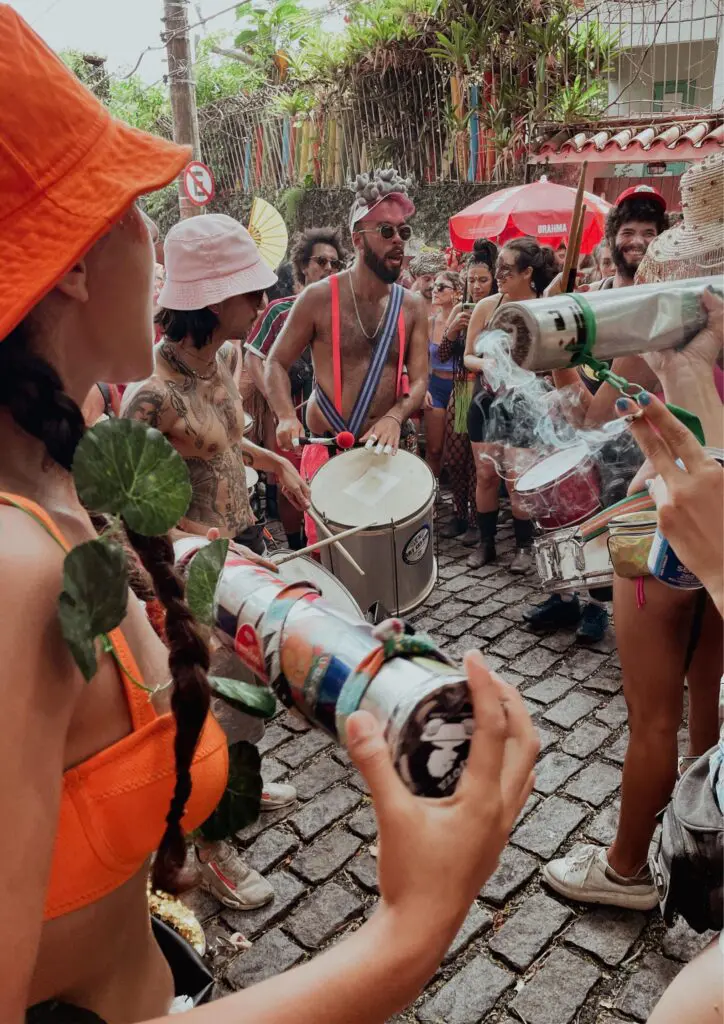This February, I was lucky enough to tick a box on my bucket list: taking part in Carnival, in Rio de Janeiro. After having spoken to locals, visited the markets, the blocos, and the infamous Sambadrome, here are my thoughts on Carnival’s environmental impact, from a sustainable fashion perspective.
What is Carnival, and where does it come from?
The history behind this monumental event is rich and intricate – stemming from events like the Greek spring festival, into the the Roman Catholic Church’s Lent (Carnival came from the word ‘Carne Vale’ which translates to ‘Goodbye to Meat’ leading up to the 40 day abstinence period), and into the slave trade and the influence of Afro-Brazilians and Samba.
Today, Carnival is considered by many as the biggest party in the world, made up of two central parts: street blocos, and samba parades at the Sambadrome (first introduced in 1932). Beyond the expectation of a great party, Carnival has also come to provide a huge economic boom for the tourism industries in major cities in Brazil, including Rio de Janeiro, Sao Paulo, Salvador, etc. As an attendee, you can expect packed crowds, Afro-Brazilian music, LOTS of dancing, intimate encounters, and elaborate and eclectic costumes.
So, parties, history, culture, dancing… What’s the problem? Well…

Carnival’s Waste Problem
For all of the good that Carnival brings both economically and culturally, there is a dark side and that is waste. When you have 800,000+ people dancing, drinking, and partying in the streets, there’s almost certainly going to be remnants of the festivities left behind. While Brazil has a pretty efficient cleanup system in place (which I witnessed first-hand), the question remains – where does this waste go, and how is it disposed of? In 2020 [for example], 3,500 tons of garbage was collected in five Brazilian capitals and that same year, the Rio de Janeiro Carnival accumulated 14% more [waste] than [2019]. Very little of this waste was destined for recycling. In fact, data from the Urban Solid Waste Management Diagnosis in Brazil indicates that only 4% of solid waste is recycled in the country. And, the issue is only getting worse.
But beyond cups and cans littering the ground, there’s something else that contributes to the annual waste produced by Carnival. You guessed it – clothing. Let’s get into it.
Relevance of Costumes During Carnival
Historically, fashion has always played a crucial role – whether it’s to showcase wealth, political power, social inequity, etc., you can mark timelines when referencing historical events based on the dyes used, the styles portrayed, fabrics used, etc. Similarly, the costumes at Carnival have significant historic and cultural relevance.
During Carnival’s early days in Italy, the festival was celebrated with a costume contest. When it arrived in Brazil, wealthy Portuguese socialites would dress up in extravagant costumes and parade through the streets while common folk watched. Masks were integrated – some say as an extension of the ever-popular masquerade balls at the time, and others say from the influence of tribal practices meant to ward off bad spirits. As more and more people took part, traditional costumes were too expensive for the average person.
By the time the official parade was established in the ‘30s – bars, hotels, etc., were all hosting their own Carnival parties, and dressing up became a central part of the tradition. As the festivities continued to grow in popularity, costumes were being made that were more and more aligned with the temperature; think summer in Brazil (History). Some say that this was a reaction to the religious significance – a wild party before a time of silence, prayer, and fasting.


So, while these costumes are rich in culture… we need to talk about their environmental impact.
Samba Parade Costumes
The elaborate floats (and the costumes on board) take a TON of time and resources to produce, and the big samba schools involved in designing and building them are looking to impress and surprise audiences and judges, year over year. The costumes are labours of love, with hundreds of people spending thousands and thousands of hours making them. “Each of the 12 top-tier Samba schools pours at least $3 million annually into over-the-top floats and costumes” and in 2014 it was reported they received a total of about $42 million in funding overall.
And, while there have been efforts across Brazil to reuse and donate old costumes after the parades, most of the time things get thrown to the curb almost immediately after the event comes to a close. Furthermore, the samba parades currently lack a formal recycling or sustainability policy. This means that every year, new floats and new costumes are made – think sequins, feathers – a lot of new plastic stuff.
More recently, there is a small movement to change this. Arts University Plymouth MA Textile Design graduate Natalia Lombardi, originally from Brazil, sought out to solve a problem deeply rooted in her heritage. Her research centres around finding biomaterials that could mimic the vibrancy and colour of the plastics we currently see throughout the festivities, and eventually, replace them. Cool, right!? You can read more about her research and see her work HERE.
Beyond this, ongoing efforts to reuse textiles and other materials from past years, or donate them to schools with less access to funding, are helping to inspire more circular practices.
But what about Carnival go-ers who aren’t participating in the Samba parades, but want to take part in the fun?!
Dressing up for Carnival Blocos
The average person who attends Carnival wants to join in on the fun. During my time in Rio de Janeiro I visited the infamous Saara (or Rua da Alfândega) in Centro where the roads are lined with booths and shops filled to the brim with cheap halloween-style costumes, glitter, face paint, crowns, jewelry, face gems, feather boas, etc. It was overwhelming, and packed with tourists looking to cram cheap disposable items into their carts. In fact, over the past 20 years, imports of largely plastic carnival party items from China to Brazil have grown more than 15-fold.



One of the biggest conversations to-date has been about the impacts of glitter. When you walk through a bloco, you will be hard-pressed to find a single person without it. For those who’ve gone above and beyond, it acts as the final touch to their extravagant look, and for those who aren’t as committed, it’s an accessible way to get involved with minimum effort. Glitter, if you aren’t aware, is just a tiny piece of plastic! And as such, it’s almost impossible to remove these microplastics from the environment after they’re washed down the drain. So, while we are starting to see alternatives (i.e. ‘biodegradable’ glitter), there is something else at play here, and it resembles the bigger questions we have around fast, and ultra-fast, fashion: the need to buy new, cheap, and fast… again and again.
Within these markets, and throughout the parties, I was hard-pressed to find anything that resembled a natural fibre. And it makes sense – why wear high quality pieces of clothing to a party where it’s sure to get spilled on, torn, or disheveled in some way? And when there’s pressure to show off a new look every day of this multi-day festival, fast fashion seems the most obvious solution – cheap, synthetic, essentially disposable clothing. In a soon to be released Canadian report on microfibers, it was estimated that “an individual wearing 1 kg of synthetic clothing for eight hours daily could release up to a billion microfibers into the atmosphere”. Now think of the 800,000+ annual Carnival participants!?
So, Where Do We Go From Here?
Following the 2023 Carnival, EMBRATUR and the city of Rio de Janeiro signed an important partnership based on UNWTO’s guidelines for Tourism Sustainability Monitoring to create a “Tourism Sustainability Index”, showing that there is both interest and government support of a more sustainable Carnival. But, while there have been steps taken to begin implementing better sustainability practices, there is still a long way to go – especially when it comes to textile waste.
From my perspective, there are some relatively simple changes that could make an impact –
- Circular design should be at the forefront for all Samba parade designers. Using natural or next generation materials, and having end of life in mind, from the beginning.
- Reusing pieces from Carnival-past, and donating what’s no longer of interest to Samba schools with lesser means that can transform it into something new next year.
- Advocating for an official sustainability policy for all Samba schools to adhere to higher standards (referencing the 7Rs of Fashion; Reduce, Reuse, Repurpose, Repair, Resell, Renting, and Recycling).
- Government partnerships with textile recycling hubs and organizations to properly discard any materials that can no longer be used.
- Introducing education to the general public, and to tourists, about the impacts of Carnival attire and alternatives to dress.
- Easily accessible, and affordable rental and/or resale options for those participating in Carnival blocos (e.g. Take back and recycling programs for bloco costumes worn by locals and tourists after the festivities have ended. )
In summary, I leave you with this: when it comes to an event like Carnival, within the context of fashion, how can we make essential changes that will be better for people and planet, without compromising the historical and cultural significance?



















ABOUT THE AUTHOR
Audrey Henderson | Communications Specialist, Fashion Takes Action
Audrey is the Communications Specialist at FTA. Passionate about sustainability, ethical production and circularity in the fashion industry, she joins our team from a local, made in Canada menswear brand. She brings 5+ years experience in digital marketing, communications and business development roles… (read more).







